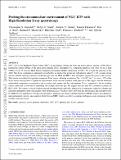Probing the circumnuclear environment of NGC 1275 with high-resolution X-ray spectroscopy
Author(s)
Reynolds, Christopher S; Smith, Robyn N; Fabian, Andrew C; Fukazawa, Yasushi; Kara, Erin A; Mushotzky, Richard F; Noda, Hirofumi; Tombesi, Francesco; Veilleux, Sylvain; ... Show more Show less
DownloadAccepted version (611.0Kb)
Open Access Policy
Open Access Policy
Creative Commons Attribution-Noncommercial-Share Alike
Terms of use
Metadata
Show full item recordAbstract
<jats:title>ABSTRACT</jats:title>
<jats:p>NGC 1275 is the brightest cluster galaxy (BCG) in the Perseus cluster and hosts the active galactic nucleus (AGN) that is heating the central 100 kpc of the intracluster medium atmosphere via a regulated feedback loop. Here, we use a deep (490 ks) Cycle-19 Chandra High-Energy Transmission Grating (HETG) observation of NGC 1275 to study the anatomy of this AGN. The X-ray continuum is adequately described by an unabsorbed power law with photon index Γ ≈ 1.9, creating strong tension with the detected column of molecular gas seen via HCN and HCO+ line absorption against the parsec-scale core/jet. This tension is resolved if we permit a composite X-ray source; allowing a column of $N_\mathrm{ H}\sim 8\times 10^{22}\hbox{${\rm \, cm}^{-2}\, $}$ to cover ∼15 per cent of the X-ray emitter does produce a significant improvement in the statistical quality of the spectral fit. We suggest that the dominant unabsorbed component corresponds to the accretion disc corona, and the sub-dominant X-ray component is the jet working surface and/or jet cocoon that is expanding into clumpy molecular gas. We suggest that this may be a common occurrence in BCG-AGN. We conduct a search for photoionized absorbers/winds and fail to detect such a component, ruling out columns and ionization parameters often seen in many other Seyfert galaxies. We detect the 6.4 keV iron-K α fluorescence line seen previously by XMM–Newton and Hitomi. We describe an analysis methodology that combines dispersive HETG spectra, non-dispersive microcalorimeter spectra, and sensitive XMM–Newton/EPIC spectra in order to constrain (sub)arcsec-scale extensions of the iron-K α emission region.</jats:p>
Date issued
2021Department
MIT Kavli Institute for Astrophysics and Space ResearchJournal
Monthly Notices of the Royal Astronomical Society
Publisher
Oxford University Press (OUP)
Citation
Reynolds, Christopher S, Smith, Robyn N, Fabian, Andrew C, Fukazawa, Yasushi, Kara, Erin A et al. 2021. "Probing the circumnuclear environment of NGC 1275 with high-resolution X-ray spectroscopy." Monthly Notices of the Royal Astronomical Society, 507 (4).
Version: Author's final manuscript